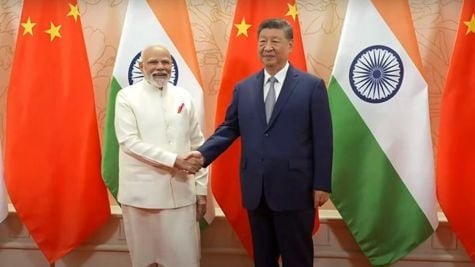Prime Minister Narendra Modi’s historic meeting with Chinese President Xi Jinping marks a pivotal moment for India China bilateral ties. The two leaders convened at the Shanghai Cooperation Organisation summit in Tianjin, signaling renewed diplomatic engagement between Asia’s largest economies.

Historic Diplomatic Breakthrough After Seven Years
Modi’s arrival in China represents his first visit in seven years. This significant diplomatic milestone comes amid global economic uncertainties and shifting geopolitical dynamics. Furthermore, the timing coincides with mounting pressure from Washington’s aggressive tariff policies affecting both nations.
The meeting between the Indian Prime Minister and Chinese President lasted approximately one hour. Both leaders were accompanied by senior officials, including India’s National Security Advisor Ajit Doval and Foreign Secretary Vikram Misri. Meanwhile, Chinese Foreign Minister Wang Yi joined President Xi for the crucial discussions.
“We are committed to taking our relations forward on the basis of mutual trust, respect and sensitivity,” Modi emphasized during the bilateral talks.
Border Disengagement Creates Stability Foundation
India China bilateral ties have witnessed remarkable progress since the Kazan meeting in October 2024. The successful disengagement of troops from contentious border areas has established an atmosphere of peace and stability. Additionally, both nations have reached consensus through their Special Representatives on effective border management protocols.
The Line of Actual Control situation, which had remained tense since 2020, now shows signs of meaningful improvement. Consequently, this border stability provides a solid foundation for expanding cooperation in various sectors. Moreover, the peaceful resolution demonstrates both countries’ commitment to diplomatic solutions.
Economic Cooperation Benefits 2.8 Billion People
Modi highlighted that the welfare of 2.8 billion citizens depends on enhanced India China bilateral ties. This cooperation extends beyond bilateral benefits to global humanitarian welfare. Therefore, strengthening economic partnerships becomes crucial for regional and international stability.
The resumption of direct flights between both countries marks another significant milestone. Previously suspended since 2020, these air connections will facilitate business travel and tourism. Subsequently, improved connectivity will boost trade relationships and cultural exchanges.
“The interests of 2.8 billion people of both countries are linked to our cooperation. This will also pave the way for the welfare of the entire humanity,” the Prime Minister stated.
Religious Tourism and Cultural Exchanges Resume
The restoration of the Kailash Mansarovar Yatra represents a meaningful gesture in India China bilateral ties. This sacred pilgrimage route holds immense spiritual significance for millions of devotees. Consequently, its reopening demonstrates both nations’ commitment to people-to-people connections.
Cultural exchanges have historically played important roles in diplomatic relationships. Similarly, religious tourism fosters mutual understanding between diverse populations. Thus, these initiatives contribute to building lasting trust between neighboring countries.
Strategic Timing Amid Global Economic Pressures
The Modi-Xi meeting occurs against the backdrop of escalating trade tensions with the United States. President Trump’s imposition of 50 percent tariffs on Indian imports has created new challenges. Nevertheless, this external pressure has paradoxically brought India and China closer together.
Both leaders recognize the importance of multilateral cooperation in addressing global challenges. Furthermore, the Shanghai Cooperation Organisation provides an ideal platform for strengthening regional partnerships. Consequently, their collaboration sends strong signals about South-South cooperation priorities.
Trust and Respect Form Relationship Foundation
Modi emphasized that mutual trust, respect, and sensitivity must guide future India China bilateral ties. These fundamental principles provide the framework for sustainable diplomatic engagement. Additionally, both leaders acknowledged the positive trajectory established since their previous Kazan meeting.
The transformation from military standoff to diplomatic cooperation showcases pragmatic leadership. Similarly, both countries have demonstrated flexibility in addressing complex bilateral challenges. Therefore, this approach offers valuable lessons for international conflict resolution.
Economic Benefits Drive Diplomatic Progress
Trade relationships between India and China have enormous potential for expansion. Currently, both nations seek balanced economic partnerships that benefit their respective populations. Moreover, removing trade barriers will create new opportunities for businesses and entrepreneurs.
The Chinese agreement to lift export restrictions on rare earths and fertilizers signals positive momentum. Likewise, tunnel boring machines and other critical equipment will enhance India’s infrastructure development. Thus, economic cooperation becomes a cornerstone of improved diplomatic relations.
Multilateral Platforms Strengthen Regional Cooperation
The SCO summit provides an excellent venue for advancing India China bilateral ties within a multilateral framework. This approach reduces bilateral tensions while promoting regional stability. Furthermore, it allows both countries to address common challenges collectively.
Other world leaders, including Russia’s Vladimir Putin, witnessed this diplomatic breakthrough. Consequently, the international community recognizes the significance of improved India-China relations. Moreover, such cooperation contributes to global peace and prosperity.
Future Prospects for Enhanced Partnership
The meeting establishes clear pathways for sustained diplomatic engagement between both nations. Regular high-level exchanges will help maintain momentum in bilateral cooperation. Additionally, working-level officials will continue implementing agreements reached by their leaders.
Both countries face similar development challenges requiring innovative solutions. Therefore, sharing experiences and best practices will benefit their respective populations. Furthermore, joint initiatives in technology and sustainable development offer promising opportunities.
Strategic Implications for Asian Geopolitics
The revival of constructive India China bilateral ties carries significant implications for Asian security architecture. Regional stability depends largely on cooperative relationships between major powers. Consequently, improved bilateral ties contribute to broader peace and prosperity across Asia.
The elephant and dragon metaphor, referenced by President Xi, symbolizes the potential for harmonious coexistence. Similarly, both ancient civilizations can learn from their rich histories of peaceful interactions. Thus, cultural wisdom complements modern diplomatic pragmatism.
This diplomatic breakthrough represents more than bilateral progress between two neighboring countries. Rather, it demonstrates how mature leadership can overcome historical differences through dialogue and mutual respect. Ultimately, the success of India China bilateral ties will benefit not only 2.8 billion citizens but contribute to global stability and human welfare in the years ahead.





